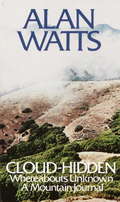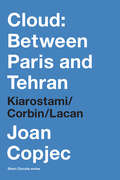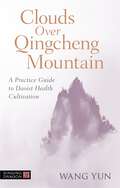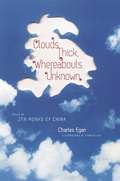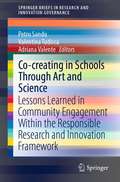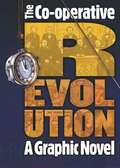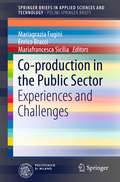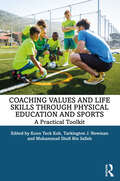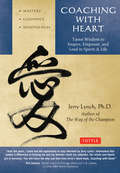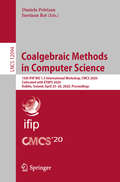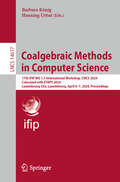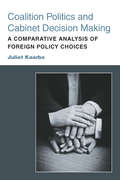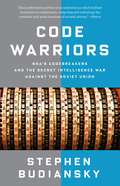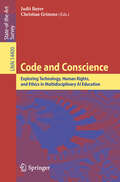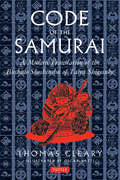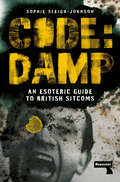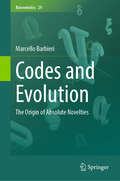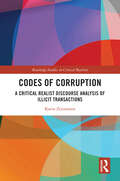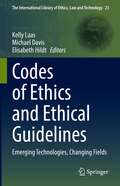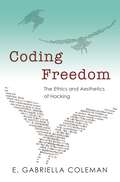- Table View
- List View
Cloud-hidden, Whereabouts Unknown: A Mountain Journal
by Alan W. WattsThese ruminations, assembled in the form of a journal and here published in paperback for the first time, were written at Alan Watts' retreat in the foothills of Mount Tamalpais, California. Many current themes are discussed, including meditation, nature, established religion, race relations, karma and reincarnation, astrology and tantric yoga, and the nature of ecstasy, but the underlying motif is the art of feeling out and following the watercourse way of nature, known in Chinese as the Tao. Watts suggests a way of contemplative meditation in which we temporarily stop naming and classifying all that we experience, and simply feel it as it is.From the Paperback edition.
Cloud: Kiarostami/Corbin/Lacan (Short Circuits)
by Joan CopjecA theoretical examination of veiling, shame, and modesty in the films of the Iranian director Abbas Kiarostami through the lenses of Islamic philosophy and Lacanian psychoanalysis.In Cloud: Between Paris and Tehran, Joan Copjec examines the films of the Iranian director Abbas Kiarostami. The key to these films, she argues, lies in the image of a fragile yet sheltering tree that appears in several of his films. This simple image depicts a central concept of Islamic philosophy, which is known as the &“Cloud&” or the &“Imaginal World.&” It designates the place out of which all the things of this world manifest themselves and &“covers,&” or veils, that which must remain hidden.The concept of the Cloud plays a significant role in defining: (1) the unique nature of the Islamic God, who is not a creator or father; (2) the nature of the image, which assumes a priority and a greater power than it is elsewhere accorded; and (3) the nature of modesty, shame, and sexuality.Copjec walks her readers through the thicket of Islamic philosophy while demonstrating how its abstract concepts produce what audiences see on screen. The most ambitious aspect of the book lies in its attempt to demonstrate the inheritance by psychoanalysis of a new notion of knowledge, or gnosis, formulated by Muslim thinkers, who radically redefined the relation between body and thought.
Clouds Over Qingcheng Mountain: A Practice Guide to Daoist Health Cultivation
by Wang YunImmersing the mind with the concepts of the Daoist path of health and immortality, Clouds over Qingcheng Mountain invokes the sacred birthplace of one of China's mystical mountains that has stimulated both mind and body for generations.Whilst the first volume, Climbing the Steps to Qingcheng Mountain, invited the reader to travel across time and through the history of China and Daoism, Clouds over Qingcheng Mountain is more focused in the book's purpose. Wang Yun places special focus on relaxation and the breath through five sets of foundational yet all-encompassing practices, such as posting, to deepen both themes. He offers tales from his life and journey, along with accessible tools to strengthen both body and qi.Bridging the gap between practical experience and philosophical background, Clouds over Qingcheng Mountain simplifies the complex practices of Daoism handed down by generations of accomplished Masters, and gifts the reader with its most valuable aspects for a modern world.
Clouds Thick, Whereabouts Unknown: Poems by Zen Monks of China (Translations from the Asian Classics)
by Charles ChuCompiled by a leading scholar of Chinese poetry, Clouds Thick, Whereabouts Unknown is the first collection of Chan (Zen) poems to be situated within Chan thought and practice. Combined with exquisite paintings by Charles Chu, the anthology compellingly captures the ideological and literary nuances of works that were composed, paradoxically, to "say more by saying less," and creates an unparalleled experience for readers of all backgrounds.Clouds Thick, Whereabouts Unknown includes verse composed by monk-poets of the eighth to the seventeenth centuries. Their style ranges from the direct vernacular to the evocative and imagistic. Egan's faithful and elegant translations of poems by Han Shan, Guanxiu, and Qiji, among many others, do justice to their perceptions and insights, and his detailed notes and analyses unravel centuries of Chan metaphor and allusion. In these gems, monk-poets join mainstream ideas on poetic function to religious reflection and proselytizing, carving out a distinct genre that came to influence generations of poets, critics, and writers. The simplicity of Chan poetry belies its complex ideology and sophisticated language, elements Egan vividly explicates in his religious and literary critique. His interpretive strategies enable a richer understanding of Mahayana Buddhism, Chan philosophy, and the principles of Chinese poetry.
Co-creating in Schools Through Art and Science: Lessons Learned in Community Engagement Within the Responsible Research and Innovation Framework (SpringerBriefs in Research and Innovation Governance)
by Adriana Valente Valentina Tudisca Petru SanduThis book represents an applied, up-to-date work on RRI developments and their potential positive impact on societies. The societal challenges of the 21st century require the ability to integrate the knowledge and expertise of different societal actors, using more innovative, efficient and open approaches. Educational methodologies are in perpetual development in their attempt to provide tentative answers to three ever-changing digital age challenges: the challenge of speed, the challenge of form/at and the challenge of persistency. The current book aims to address these issues by presenting relevant case studies in the field of art, science and giving value to territory that, by the means of projects and initiatives using RRI consistent methodologies, have succeeded in their attempt to: preserve and valorise cultural heritage by using digital storytelling or crowddreaming methodology, develop educational strategies grounded on RRI and Open Schooling principles, contribute to new ways of thinking in the school environment by using RRI and promote gender equality and stimulate critical reflections on women’s role in science by the means of storytelling and RRI concepts.
Co-operative Revolution
by PolypAs the dominant economic system is increasingly called into question, the time of the co-operative has well and truly come. Illustrating the history of the co-operative movement from its humble beginnings in the north of England to a worldwide network, this graphic novel presents a robust foundation for future well-being. Using a range of styles and cartoon pastiches, Polyp brings to life ideas and people who are rebooting a sustainable economy.Radical cartoonist and activist Polyp has worked with campaigning organizations around the world for over fifteen years. He lives and works in a co-operative housing complex in Manchester, England. <P><P> <i>Advisory: Bookshare has learned that this book offers only partial accessibility. We have kept it in the collection because it is useful for some of our members. Benetech is actively working on projects to improve accessibility issues such as these.</i>
Co-operative Revolution (Kindle Edition)
by PolypAs the dominant economic system is increasingly called into question, the time of the co-operative has well and truly come. Illustrating the history of the co-operative movement from its humble beginnings in the north of England to a worldwide network, this graphic novel presents a robust foundation for future well-being. Using a range of styles and cartoon pastiches, Polyp brings to life ideas and people who are rebooting a sustainable economy.Radical cartoonist and activist Polyp has worked with campaigning organizations around the world for over fifteen years. He lives and works in a co-operative housing complex in Manchester, England. <P><P> <i>Advisory: Bookshare has learned that this book offers only partial accessibility. We have kept it in the collection because it is useful for some of our members. Benetech is actively working on projects to improve accessibility issues such as these.</i>
Co-production in the Public Sector: Experiences and Challenges (SpringerBriefs in Applied Sciences and Technology)
by Mariagrazia Fugini Enrico Bracci Mariafrancesca SiciliaThis book examines the various ways in which co-production can contribute to the creation, design, and delivery of public services, namely by engaging the expertise of users and their networks, by promoting public services that are better targeted and more responsive to users, by cutting costs against the background of austerity in public finance, by creating a synergy between government and civil society that will impact positively on social capital, and by addressing the challenges resulting from growing democratic and citizenship deficits. Particular attention is paid to local government and the health and social care sector. After definition of the concept of co-production, the critical issues which arise when public services are co-produced are discussed. Various experiences of co-production are presented and analyzed with a view to highlighting why, how, and with what effect public service co-production may be implemented. Individual chapters focus on the impact of co-production in making cities smarter and the use of ICT in supporting co-production of public services. The book will be of relevance to a wide readership, from students to academics and professionals interested or engaged in public service management.
Coaching Values and Life Skills through Physical Education and Sports: A Practical Toolkit
by Koon Teck Koh Tarkington J Newman Muhammad Shufi Bin SallehThis impactful resource guide is for international educators and practitioners involved in Physical Education and Sport (PES) who want to learn evidence-based approaches to the teaching of values and character education. Through a systematic approach to teaching and evaluating values and character education, this book bridges the gap between theory and practice. It offers empirical evidence and strategies to show how values and character can be internalized, through carefully designed experiences, active participation, and regular reinforcement, without compromising the time needed to learn sports skills - a common concern raised by PE teachers and sports coaches. Results from case studies have also revealed that values can be transferred beyond the context of physical education lessons and sports through a collaborative approach and effective communication between teachers, coaches, and parents. Key strategies based on empirical evidence are highlighted in this book. It also highlights an Asian perspective on values and life skills training through Physical Education and provides readers with step-by-step implementation guidelines to simplify some complex strategies in developing values and life skills through PES seamlessly.The book provides useful information to anyone engaged in developing young people in, and through, sport. In particular it will be of great value to pre-service and in-service teachers and coaches for implementing effective strategies to balance teaching sports skills, values, and life skills effectively in PES.
Coaching with Heart
by Chungliang Al Huang Jerry LynchIn the world of athletics, an innovative breed of coaches is emerging--men and women who insist on fostering strong, healthy relationships with their players where respect and integrity are forged--and they are winning!In Coaching with Heart, recognized sports psychologist Dr. Jerry Lynch declares that the relationship game is the single most vital aspect to successful and effective coaching in sports. By creating more intimacy between coach and team, and recognizing that both team and coach can learn from each other, everyone is able to fulfill their mutual goals.Coaching With Heart is a provocative and practical 'game changer' in the shifting landscape of athletics and life coaching. Awaken to established techniques that empower and inspire not only yourself, but also the players with whom you are building a relationship. Chapters within discuss various themes, including the power of caring in HAVING LOVE IN YOUR HEART, to the magic of being stronger by being softer in SOFTER EFFORT, STRONG RESULT, to the positive effects of a culture of unity and cohesion in CULTURE OF WE NOT ME. Tao Coaching, where the Taoist virtues of respect, trust, compassion, belief, and integrity are also discussed.Dr. Lynch shares wisdom he has accrued in his more than thirty years 'in the trenches', where he has had the opportunity to work with some of the most respected and effective coaches of all time, such as Phil Jackson, Pat Summit, Dean Smith, Tara Vanderveer, Bill Walsh, Anson Dorrance, Cindy Timchal, Missy Foote, and many more. Coaching with Heart will assist you in stepping outside the box with your leadership endeavors whether as a coach, teacher, CEO, military officer, or parent, and implement Zen Coaching approaches to guide others to practice, play, and live with the heart of a champion.
Coaching with Heart
by Chungliang Al Huang Jerry LynchIn the world of athletics, an innovative breed of coaches is emerging--men and women who insist on fostering strong, healthy relationships with their players where respect and integrity are forged--and they are winning!In Coaching with Heart, recognized sports psychologist Dr. Jerry Lynch declares that the relationship game is the single most vital aspect to successful and effective coaching in sports. By creating more intimacy between coach and team, and recognizing that both team and coach can learn from each other, everyone is able to fulfill their mutual goals.Coaching With Heart is a provocative and practical 'game changer' in the shifting landscape of athletics and life coaching. Awaken to established techniques that empower and inspire not only yourself, but also the players with whom you are building a relationship. Chapters within discuss various themes, including the power of caring in HAVING LOVE IN YOUR HEART, to the magic of being stronger by being softer in SOFTER EFFORT, STRONG RESULT, to the positive effects of a culture of unity and cohesion in CULTURE OF WE NOT ME. Tao Coaching, where the Taoist virtues of respect, trust, compassion, belief, and integrity are also discussed.Dr. Lynch shares wisdom he has accrued in his more than thirty years 'in the trenches', where he has had the opportunity to work with some of the most respected and effective coaches of all time, such as Phil Jackson, Pat Summit, Dean Smith, Tara Vanderveer, Bill Walsh, Anson Dorrance, Cindy Timchal, Missy Foote, and many more. Coaching with Heart will assist you in stepping outside the box with your leadership endeavors whether as a coach, teacher, CEO, military officer, or parent, and implement Zen Coaching approaches to guide others to practice, play, and live with the heart of a champion.
Coalgebraic Methods in Computer Science: 15th IFIP WG 1.3 International Workshop, CMCS 2020, Colocated with ETAPS 2020, Dublin, Ireland, April 25–26, 2020, Proceedings (Lecture Notes in Computer Science #12094)
by Daniela Petrişan Jurriaan RotThis book constitutes the thoroughly refereed post-conference proceedings of the 15th International Workshop on Coalgebraic Methods in Computer Science, CMCS 2020, colocated with ETAPS 2020, held in Dublin, Ireland, in April 2020. The conference was held as several online events in September and October due to the COVID-19 pandemic. The 9 revised full papers were carefully reviewed and selected from 13 submissions. Also included is one invited talk. The papers cover a wide range of topics in the theory, logics, and applications of coalgebras.
Coalgebraic Methods in Computer Science: 17th IFIP WG 1.3 International Workshop, CMCS 2024, Colocated with ETAPS 2024, Luxembourg City, Luxembourg, April 6–7, 2024, Proceedings (Lecture Notes in Computer Science #14617)
by Barbara König Henning UrbatThis book constitutes the post-conference proceedings of the 17th International Workshop on Coalgebraic Methods in Computer Science, CMCS 2024, colocated with ETAPS 2024, held in Luxembourg in April 2024. The 10 papers included in these proceedings were carefully reviewed and selected from 15 submissions. The papers cover a wide range of topics on theory, logics, and applications of coalgebras.
Coalition Politics and Cabinet Decision Making: A Comparative Analysis of Foreign Policy Choices
by Juliet KaarboEvery day, coalition cabinets make policy decisions critical to international politics. Juliet Kaarbo examines the dynamics of these multiparty cabinets in parliamentary democracies in order to assess both the quality of coalition decision making and the degree to which coalitions tend to favor peaceful or military solutions. Are coalition cabinets so riddled by conflict that they cannot make foreign policy effectively, or do the multiple voices represented in the cabinet create more legitimate and imaginative responses to the international system? Do political and institutional constraints inherent to coalition cabinets lead to nonaggressive policies? Or do institutional and political forces precipitate more belligerent behavior? Employing theory from security studies and political psychology as well as a combination of quantitative cross-national analyses and twelve qualitative comparative case studies of foreign policy made by coalition cabinets in Japan, the Netherlands, and Turkey, Kaarbo identifies the factors that generate highly aggressive policies, inconsistency, and other policy outcomes. Her findings have implications not merely for foreign policy but for all types of decision making and policy-making by coalition governments.
Code Warriors: NSA's Codebreakers and the Secret Intelligence War Against the Soviet Union
by Stephen BudianskyA sweeping, in-depth history of NSA, whose famous "cult of silence" has left the agency shrouded in mystery for decades The National Security Agency was born out of the legendary codebreaking programs of World War II that cracked the famed Enigma machine and other German and Japanese codes, thereby turning the tide of Allied victory. In the postwar years, as the United States developed a new enemy in the Soviet Union, our intelligence community found itself targeting not soldiers on the battlefield, but suspected spies, foreign leaders, and even American citizens. Throughout the second half of the twentieth century, NSA played a vital, often fraught and controversial role in the major events of the Cold War, from the Korean War to the Cuban Missile Crisis to Vietnam and beyond. In Code Warriors, Stephen Budiansky--a longtime expert in cryptology--tells the fascinating story of how NSA came to be, from its roots in World War II through the fall of the Berlin Wall. Along the way, he guides us through the fascinating challenges faced by cryptanalysts, and how they broke some of the most complicated codes of the twentieth century. With access to new documents, Budiansky shows where the agency succeeded and failed during the Cold War, but his account also offers crucial perspective for assessing NSA today in the wake of the Edward Snowden revelations. Budiansky shows how NSA's obsession with recording every bit of data and decoding every signal is far from a new development; throughout its history the depth and breadth of the agency's reach has resulted in both remarkable successes and destructive failures. Featuring a series of appendixes that explain the technical details of Soviet codes and how they were broken, this is a rich and riveting history of the underbelly of the Cold War, and an essential and timely read for all who seek to understand the origins of the modern NSA.From the Hardcover edition.
Code and Conscience: Exploring Technology, Human Rights, and Ethics in Multidisciplinary AI Education (Lecture Notes in Computer Science #14400)
by Christian Grimme Judit BayerThis volume originated from an international, interdisciplinary research course organized by the Institute of Information Management of the University of Münster in 2021-2022, funded by the DAAD IVAC sponsorship program. The coauthors and their contributions represent different disciplines, fusing perspectives of law and information sciences. The contributions present current issues in AI, ethics and human rights, policing, privacy and surveillance, social media, and data protection. The book has a further mission: it offers insight into a novel educational format that combines an intercultural learning environment with interdisciplinary co-working, e-learning methods, peer education, and interactive group work.
Code of the Samurai
by Thomas Cleary Oscar RattiCode of the Samurai is a four-hundred-year-old explication of the rules and expectations embodied in Bushido, the Japanese way of the warrior. Bushido has played a major role in shaping the behavior of modern Japanese government, corporations, society, and individuals, as well as in shaping the modern martial arts within Japan and internationally. The Japanese original of this book has been one of the primary sources on the tenets of Bushido, a way of thought that remains fascinating to modern world, East and West.
Code of the Samurai
by Thomas Cleary Oscar RattiCode of the Samurai is a four-hundred-year-old explication of the rules and expectations embodied in Bushido, the Japanese way of the warrior. Bushido has played a major role in shaping the behavior of modern Japanese government, corporations, society, and individuals, as well as in shaping the modern martial arts within Japan and internationally. The Japanese original of this book has been one of the primary sources on the tenets of Bushido, a way of thought that remains fascinating to modern world, East and West.
Code of the Samurai
by Thomas Cleary Oscar RattiLearn the ways of the Japanese Bushido Code with this very readable, modern translation of the Bushido Shoshinshu.Code of the Samurai is a four-hundred-year-old explication of the rules and expectations embodied in Bushido, the Japanese Way of the Warrior. Bushido has played a major role in shaping the behavior of modern Japanese government, corporations, society, and individuals, as well as in shaping modern Japanese martial arts within Japan and internationally.The Japanese original of this book, Bushido Shoshinshu, (Bushido for Beginners), has been one of the primary sources on the tenets of Bushido, a way of thought that remains fascinating and relevant to the modern world, East and West.With a clear, conversational narrative by Thomas Cleary, one of the foremost translators of the wisdom of Asia, and powerfully evocative line drawings by master illustrator Oscar Ratti, this book is indispensable to the corporate executive, student of the Asian Culture, martial artist, those interested in Eastern philosophy or military strategy, as well as for those simply interested in Japan and its people.
Code: An Esoteric Guide to British Sitcoms
by Sophie Sleigh-JohnsonAn alternative occult and esoteric history of England told through one of its most popular cultural forms: the comedy sitcom.Code: Damp is a sometimes-comedic field report that charts an esoteric code hidden within the twin poles of 1970s sitcoms Rising Damp and The Fall and Rise of Reginald Perrin. Outlining how past cultural patterns condensate and repeat through technology, time is shown to be a damp condensation seeping through the centuries and out onto the telly. Interspersed with the author&’s own photographs, prints, Holsten Pils cans, local newspaper entries and carrier bags, as well as a whole host of other characters, the work seems an antiquarian&’s conceit that takes time travel as a metaphoric methodology. This is not media studies; more an allegory of all reality as (tele)visual recorded history, excavating the strata of haunted technology from which the fragile band of code comprising our sense of time is briefly emitted. Drawing connections between incidents of ancient and popular culture, from Mark E. Smith&’s lyric— &“They say damp records the past&”—to Rising Damp&’s (meta)physical structure of decay, the book finds damp&’s temporal power manifest in everything from alchemy, mysticism, and parish folklore to pulp, Time Team, darts, the local newspaper and, of course, the sitcom. Merging the vast with the parochial, the occult with the comedic, Code: Damp tunes into the weird demands of damp as a time-traveling material at the intersections of comedy, myth and technology, taking all three as serious resources to better (dis)orient the ground we stand on.
Codes and Evolution: The Origin of Absolute Novelties (Biosemiotics #29)
by Marcello BarbieriThis text builds upon the over 1500 papers published in peer-reviewed journals revealing that there are more than 200 biological codes in living systems. The author claims this experimental fact is bound to change biology forever. This book shows how this very discovery reveals that coding is a new mechanism of life, just as the discovery of electromagnetism revealed the existence of a new physical force in the universe. The existence of many biological codes, furthermore, Barbieri argues, is one of those experimental facts that have extraordinary theoretical consequences. It implies that coding is not only a mechanism that constantly operates in all living systems, but also a mechanism of evolution, more precisely a mechanism that gave origin to the absolute novelties of the history of life. This amounts to saying that evolution took place by two distinct mechanisms, by natural selection and by natural conventions, two mechanisms that are fundamentally different because natural selection is the result of copying and deals with information whereas natural conventions are the result of coding and deal with meaning. This volume appeals to students and researchers working in the fields of semiotics, philosophy, biology and mathematics.
Codes of Corruption: A Critical Realist Discourse Analysis of Illicit Transactions (Routledge Studies in Critical Realism)
by Karin ZotzmannCorruption is expanding internationally and so are strategic accusations of others being corrupt. It has become quite common for some politicians and their supporters to make false accusations of corruption against opponents in order to win power. A precise understanding of the phenomenon is therefore urgently needed for economic and political governance. The phenomenon has so far been investigated from the disciplines of sociology, criminology, politics, and economics, but rarely with a focus on the actual negotiation of corrupt deals. This is mainly because access to these illegal, often discursively mediated, practices is highly complicated. Empirical studies have therefore either focused quantitatively on the number of cases that came to light or on perceptions of and attitudes towards the phenomenon.Codes of Corruption attempts to fill this gap. It draws on a corpus of videos and audio recordings from Mexico secretly recorded by individuals who were present at the time and later uploaded to a public streaming platform. This corpus was analyzed through a variety of analytical tools to show the interactional and discursive work participants engage in to come to an agreement and, at the same time, the structural configurations that enabled, constrained, and motivated the participants. To capture these multidimensional causal configurations and avoid the pitfalls of reductionism, the theoretical and methodological framework adopted in this research is based on the philosophy of Critical Realism.Through this innovative approach, the book aims to contribute to debates and emerging research agendas in the study of corruption and thus to further the conceptualization of the phenomenon, its causes, and potential remedies. Its results will be of interest to researchers in the above-mentioned disciplines as well as to those working in Critical Discourse Analysis, Critical Realism, Interactional Sociolinguistics, and Pragmatics. Codes of Corruption will also be of interest to a wider audience of governmental and non-governmental institutions that engage in the design of anti-corruption strategies, training, and education.
Codes of Ethics and Ethical Guidelines: Emerging Technologies, Changing Fields (The International Library of Ethics, Law and Technology #23)
by Michael Davis Elisabeth Hildt Kelly LaasThis book investigates how ethics generally precedes legal regulation, and looks at how changes in codes of ethics represent an unparalleled window into the research, innovation, and emerging technologies they seek to regulate. It provides case studies from the fields of engineering, science, medicine and social science showing how professional codes of ethics often predate regulation and help shape the ethical use of emerging technologies and professional practice. Changes in professional ethics are the crystallization of ongoing conversation in scientific and professional fields about how justice, privacy, safety and human rights should be realized in practice where the law is currently silent. This book is a significant addition to this area of practical and professional ethics and is of particular interest to practitioners, scholars, and students interested in the areas of practical and applied ethics.
Coding Freedom: The Ethics and Aesthetics of Hacking
by E. Gabriella ColemanWho are computer hackers? What is free software? And what does the emergence of a community dedicated to the production of free and open source software--and to hacking as a technical, aesthetic, and moral project--reveal about the values of contemporary liberalism? Exploring the rise and political significance of the free and open source software (F/OSS) movement in the United States and Europe, Coding Freedom details the ethics behind hackers' devotion to F/OSS, the social codes that guide its production, and the political struggles through which hackers question the scope and direction of copyright and patent law. In telling the story of the F/OSS movement, the book unfolds a broader narrative involving computing, the politics of access, and intellectual property. E. Gabriella Coleman tracks the ways in which hackers collaborate and examines passionate manifestos, hacker humor, free software project governance, and festive hacker conferences. Looking at the ways that hackers sustain their productive freedom, Coleman shows that these activists, driven by a commitment to their work, reformulate key ideals including free speech, transparency, and meritocracy, and refuse restrictive intellectual protections. Coleman demonstrates how hacking, so often marginalized or misunderstood, sheds light on the continuing relevance of liberalism in online collaboration.
Coercion and Social Welfare in Public Finance
by Jorge Martinez-Vazquez Stanley L. WinerAlthough coercion is a fundamental and unavoidable part of our social lives, economists have not offered an integrated analysis of its role in the public economy. The essays in this book focus on coercion arising from the operation of the fiscal system, a major part of the public sector. Collective choices on fiscal matters emerge from and have all the essential characteristics of social interaction, including the necessity to force unwanted actions on some citizens. This was recognized in an older tradition in public finance which can still serve as a starting point for modern work. The contributors to the volume recognize this tradition, but add to it by using contemporary frameworks to study a set of related issues concerning fiscal coercion and economic welfare. These issues range from the compatibility of an open access society with the original Wicksellian vision to the productivity of coercion in experimental games.
